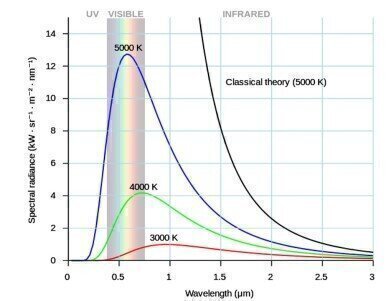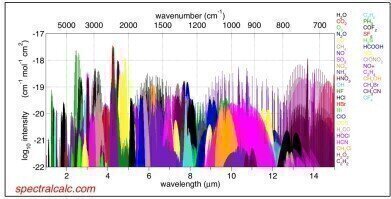-
 Planck Black body curves for various temperatures (Spectral radiation vs wavelength) https://commons.wikimedia.org/wiki/File:Black_body.svg
Planck Black body curves for various temperatures (Spectral radiation vs wavelength) https://commons.wikimedia.org/wiki/File:Black_body.svg -
 Infrared absorption bands of all major trace gases https://commons.wikimedia.org/wiki/File:Spectralcalc_infrared_bands.png
Infrared absorption bands of all major trace gases https://commons.wikimedia.org/wiki/File:Spectralcalc_infrared_bands.png
Gas Detection
N.E.T Black Body technology dramatically extends the range of NDIR-detected gases
Aug 01 2018
N.E.T. feature the market’s most comprehensive range of NDIR-detected gases. Indeed, we extend the emission spectrum of our instruments with the use of a state-of-the-art, MEMS-based IR source featuring true blackbody radiation characteristics. Just how and why we use this technology to our advantage?
Non-Dispersive Infrared sensors for CO2 and Hydrocarbons normally use classic filament lamps as their IR radiation emitter. Such lamps have represented performing and cost-effective IR emittance sources for instruments manufacturers worldwide for years. They are commonly limited to an emission spectrum of 500nm and under, as the glass bulb comprising the filament 'cuts' all wavelengths beyond that limit. As CO2, Methane, Propane and other hydrocarbons all can be observed with absorbance bands below 500nm, a filament lamp works just fine for them.
However, a large number of gases absorb IR radiation beyond 500nm (or 5 µm). To detect them, a filament lamp would be useless. Among them, SF6, Ethylene and all the commonly used refrigerant gases. To detect them, you would need a source capable of emitting in the spectrum of 8 to 10µm. For this specific reason, sensors such as the N.E.T.’S IREF series use a MEMS-based IR source, featuring true blackbody radiation characteristics.
Black body emission is an electromagnetic radiation emitted by an object in a condition of thermodynamic equilibrium. An object is considered a perfect black body when it absorbs all the incoming light and does not reflect any. In theory, a black body source emits energy in the full spectrum of wavelengths, whether in the ultraviolet, visible, infrared spectrums as well as other wavelengths. The black body source emits a known amount of energy for an infinite number of wavelengths. The radiation is emitted according to Planck’s law.
MEMS (Microelectromechanical systems) IR sources have superior speed and efficiency. Surface emitters possess a dedicated emission layer, rendering them highly energy efficient across the entire spectral band. They have a monolithic structure providing excellent resistance against shocks and vibration. It also has smaller energy consumptions than filament lamps, as the source only needs to be powered for a short time.
The use of Black Body Sources allows N.E.T. to extend the classic scope of Infrared sensing, to bring you the market’s most comprehensive range of NDIR-detected gases.
Main advantages of N.E.T. Black Body Source:
- True black body radiation
- Wide wavelength range (2 to 14 μm)
- High emissivity,
- Long lifetime
- Fast electrical modulation (no chopper wheel needed)
- Low power consumption
- Rugged MEMS design
Digital Edition
IET 34.2 March 2024
April 2024
Gas Detection - Biogas batch fermentation system for laboratory use with automatic gas analysis in real time Water/Wastewater - Upcycling sensors for sustainable nature management - Prist...
View all digital editions
Events
Apr 22 2024 Hannover, Germany
Apr 22 2024 Marrakech, Morroco
Apr 23 2024 Kuala Lumpur, Malaysia
Apr 23 2024 Kintex, South Korea
Apr 23 2024 Edmonton, AB, Canada

















